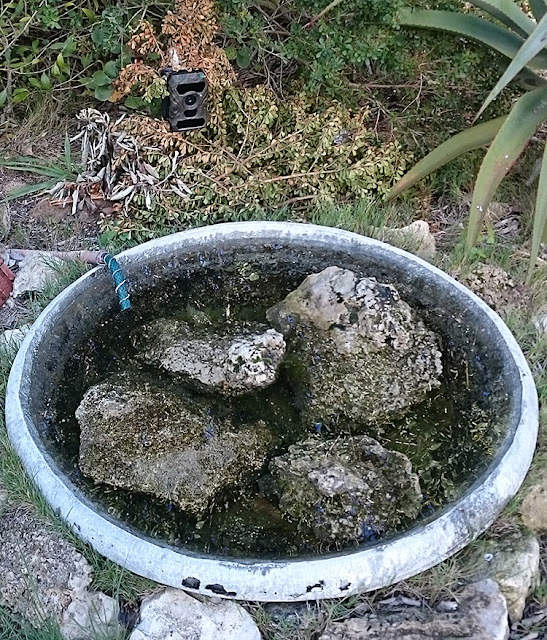 |
| SecaCam HomeVista monitoring the birdbath 24/7 |
I had the camera monitoring the birdbath for 12 days. In total the camera recorded 140 observations. In total 20 bird species, one mammal species, one unknown reptile species and the local Clicking Stream Frogs showed up. I suspect that many bats also came to drink, on the wing, but I didn't get a clear enough photograph to be sure.

On the one hand I feel OK about the 20 bird species. My personal bird count for the property is currently at 66 species, so camera trapping about a third of the species at the birdbath sounds like a pretty good start.
However, I don't feel good about the only mammal species, especially considering the species in question: The bringer of destruction, the Domestic Cat...
 |
| Southern Boubou (Suidelike Waterfiskaal - Laniarius ferrugineus) on the left, and Laughing Dove (Rooiborsduifie - Streptopelia senegalensis) in the back |
There were at least two different cats frequenting the birdbath. These cats are new on the scene. As a result I've noticed a major decrease in animal activity on the property. I heard talk that one of the cats a few houses down the road recently spawned new young and that there are now something like 9 cats roaming around, destroying everything in the area...
In the past Small Grey Mongoose and Large-Spotted Genet would frequent the property but this time around they stayed away. I don't think they avoid the cats directly, but instead the cats have likely killed to many of the small prey animals in the area. As a result the wild predators likely prefer to hunt in areas with more prey, and thus with less cats... (As proof of the decrease in the amount of prey available I've noticed a drastic decrease in the number of Clicking Stream Frogs at the birdbath.)
 |
| Sombre Greenbul (Gewone Willie - Andropadus importunes) coming for a bath |
The Sombre Greenbul are common in the area, but they are secretive and like to hide in the thick vegetation. Seeing one out in the open like this is a nice treat.
I don't often see the African Firefinch, and this one below visited the birdbath only once.
 |
| African Firefinch (Kaapse Vuurvinkie - Lagonosticta rubricate) coming for a drink |
Interestingly some species, like the sunbirds, are very common on the property, but almost never seem to visit the birdbath.
Some time after I bought the birdbath a Brown-Hooded Kingfisher started frequenting our property. I think it happened shortly after I installed the pipe to redirected the rain water from the roof into the birdbath, to help keep the water fresh and maintain the water level better.
 |
| Brown-Hooded Kingfisher (Bruinkopvisvanger - Halcyon albiventris) bathing on the wing |
I'm fairly sure the kingfisher wasn't trying to catch anything, but was rather bathing - by diving into the water repeatedly. Like many other Kingfisher species this one is not restricted to catching fish for a living. Instead they catch all sorts of insects and other small critters, not just fish.
 |
| The Unknown Reptile waving us farewell... |
Along with the camera trapping, you ought to be live trapping cats.
ReplyDeleteI admit, the thought of doing worse than simple live trapping did cross my mind... ;)
Delete